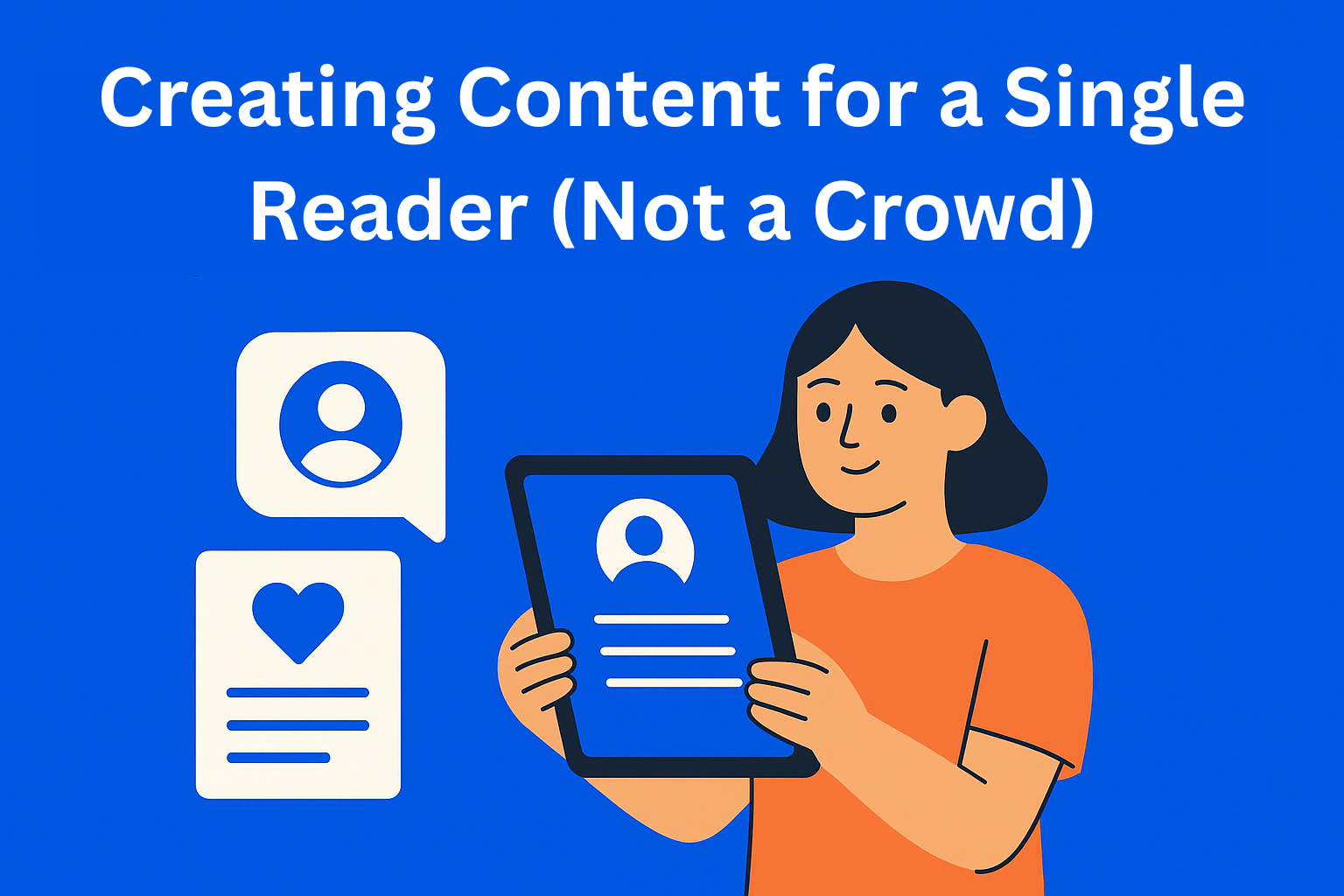The Power of One: Creating Content for a Single Reader (Not a Crowd)
Writing for one reader turns content into real conversation. Discover how authentic, focused writing builds trust, emotional connection, and engagement, because when you speak to one person, your message reaches everyone.

When you try to please everyone, you end up connecting with no one. If you write for everyone, your voice becomes unclear and impersonal, and your message gets lost. It’s much better to write for one reader - a person who represents the needs and desires of your audience.
When you write for one person, your text sounds more genuine and natural. It feels like a conversation, not a speech. That’s the essence of authentic content that connects people.
Key Takeaways
- Writing for one reader creates clarity - A focused message resonates more deeply than one aimed at the masses.
- Emotion beats generalization - Personal, direct content builds trust and feels more like a real conversation.
- A clear persona guides your voice - Defining an ideal reader helps you choose tone, language, and topics that truly connect.
- Authenticity drives engagement - Readers respond to honest tone, second-person voice, real-life examples, and warmth.
- One reader can unlock many - The more genuine and focused the message, the more people will see themselves in it and share it.
1. What It Means to Write for One Reader
Writing for one reader doesn’t mean ignoring everyone else. It means creating focus. Your “one reader” is an imaginary person who best represents your audience. They have specific needs, problems, and goals. For example:
Emily, 29 years old, works in marketing. She wants to write honest and authentic texts but worries about sounding unprofessional.
When you have such a clear picture in your mind, you know how to speak, which words to use, and what tone to keep. Instead of asking “what will everyone like?”, you ask: “Will this help Emily?”
The moment you stop writing for the crowd, your content gains a soul. That’s what makes the difference between boring and engaging content.
2. Why One Is Stronger Than Many
People don’t respond to general messages; they respond to stories. When a text is honest and personal, it easily touches emotions.
Writing for one reader builds trust. The reader feels like they’re talking to you, not to a brand. That’s where true connection begins.
Imagine you’re talking to a friend over coffee. Use simple words, real-life examples, and a warm tone. That’s how real communication happens.
3. How to Create Your Ideal Reader
For your content to have focus, you need to know who you’re writing for. Here’s a simple process for creating your ideal reader:
- Research your audience. Look at comments, messages, questions on social media, or in emails. People are already telling you what they need.
- Identify common traits. What do they share? Goals, frustrations, communication style?
- Write a mini profile. Give this person a name, age, job, goal, biggest obstacle, and motivation.
- Write for them. When you create new content, imagine explaining things directly to that person.
This approach helps you create personalized content that feels natural, not promotional. Instead of trying to cover every topic, you focus on what your reader truly wants to hear.
4. Writing for One: Practical Tips
Here are a few simple strategies you can apply right away:
- Use second person (“you”). People love being addressed directly. It creates a sense of closeness and trust.
- Write like you talk. There’s no need for complicated sentences. Simplicity is your biggest advantage.
- Ask questions. For example: “Have you ever wanted to write a blog but didn’t know where to start?” This way, you engage your reader.
- Tell stories. People remember stories, not information. If you illustrate something with an example, it becomes vivid and interesting.
- Focus on one main problem. Don’t try to explain everything in one piece. A clear message has more power.
Small changes can completely transform your style. That’s how you create engaging content people love to read because they feel understood.
5. Example: Writing for the Crowd vs. Writing for One
Text for the crowd:
Dear readers, today we’ll talk about how to improve your communication with your audience. Each of you has your own methods, but it’s important to stay consistent and authentic.
Text for one person:
You know that feeling when you write something and it seems like no one connects with it? You put in time and effort, but the reactions are weak? Let’s see how you can write in a way that truly reaches people.
The difference is clear. The first text is cold and generic, while the second feels close, like a conversation. That’s the power of writing for one reader - authenticity.
6. How One Reader Creates a Wider Audience
It’s interesting - the more you write for one person, the more people see themselves in your words. People immediately feel honesty. If your text carries emotion, warmth, and understanding, many will recognize themselves in it.
That’s when your content starts living on its own - spreading and reaching new readers. Not because it’s perfect, but because it’s genuine and natural.
Honesty always attracts more than perfection. People don’t look for perfect brands, but for those that are warm, real, and sincere - brands that understand, empathize, and tell stories from the heart.
7. Mistakes to Avoid
When you start writing for one reader, it’s easy to fall into a few traps:
- Overcomplicating personas. You don’t need a 10-page document. It’s enough to have a clear mental image.
- Writing without emotion. If your tone isn’t warm and natural, even the most beautiful sentences lose meaning.
- Copying someone else’s style. Your voice is your strength. People recognize authenticity.
Mistakes are normal, but awareness is key. When you know who you’re writing for, it’s easier to stay consistent.
Conclusion: The Power of One Person
Writing for one reader isn’t limiting. It’s freeing. When you know exactly who you’re talking to, you also know how to write. Every word has purpose, every paragraph carries meaning.
Don’t try to impress the crowd. Instead, connect with one person. Because if your text touches one reader, they’ll share it with others. And that’s how real influence begins.
"Speak to one person deeply, and the world will listen quietly."
So next time you sit down to write, don’t imagine thousands of people behind the screen. Imagine just one. Talk to them. Write for them. And you’ll see - the power of one can touch many.






